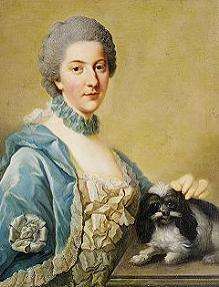Elisabeth Christine of Brunswick-Wolfenbüttel, Crown Princess of Prussia
| Elisabeth Christine of Brunswick-Wolfenbüttel | |||||
|---|---|---|---|---|---|
| Crown Princess of Prussia | |||||
 Portrait by Johann Georg Ziesenis, 1765. | |||||
| Born |
8 November 1746 Wolfenbüttel | ||||
| Died |
18 February 1840 (aged 93) Stettin | ||||
| Burial |
19 July 1849 Ducal Castle Crypt, Stettin | ||||
| Spouse | Frederick William, Crown Prince of Prussia | ||||
| Issue | Princess Frederica Charlotte, Duchess of York and Albany | ||||
| |||||
| House |
House of Brunswick-Bevern (by birth) House of Hohenzollern (by marriage) | ||||
| Father | Charles I, Duke of Brunswick-Wolfenbüttel | ||||
| Mother | Philippine Charlotte of Prussia | ||||
Elisabeth Christine Ulrike of Brunswick-Wolfenbüttel (Elisabeth Christine Ulrike; 8 November 1746 – 18 February 1840), was the first wife of Crown Prince Frederick William, her cousin and the future king Frederick William II of Prussia.
She was the seventh child and third daughter of Charles I, Duke of Brunswick-Lüneburg and Princess Philippine Charlotte of Prussia, the sister of Frederick the Great. She held the rank of Duchess in Brunswick with the style of Her Serene Highness Princess Elisabeth Christine.
Life
She was selected as a suitable bride for the heir of the throne of Prussia for his uncle, the childless King, who considered her particularly witty and beautiful. The marriage ceremony between Elisabeth Christine and Crown Prince Frederick William was originally planned to take place at Charlottenburg Palace's Chapel, but at the end took place on 14 July 1765, on the family country estate Schloss Salzdahlum.
Soon it became clear the couple was not happy with each other. King Frederick had hoped that the marriage would lead to the production of an heir, but instead noticed that Frederick William neglected his wife and was unfaithful to her on a daily basis with a series of dancers and actresses. When their first child proved to be a girl (Princess Frederica Charlotte, born 7 May 1767; she later married Prince Frederick, Duke of York and Albany), their relationship deteriorated.
Wounded by her husband's neglect and infidelity, the Crown Princess began to have affairs with young officers of the Potsdam Guard. In a letter wrote to his sister (and Elisabeth Christine's mother) Philippine Charlotte, the concerned King says:
- The husband, young and immoral, practiced a debauched life daily; the princess his wife, who was in the prime of her beauty, found herself grossly insulted by the low regard that her own charm had over him. Her vivacity and good opinion of herself, took her to avenge the offenses against her. Soon she found herself in such debauchery that hardly inferior to those of her husband; the disaster broke out and became public.
This scandal finally erupted when, as was noted by Friedrich Wilhelm von Thulemeyer,[1] the Crown Princess became pregnant by her lover, a musician called Pietro. By late January 1769 they planned to escape to Italy, but she was betrayed. Elisabeth Christine terminated her pregnancy with drugs.[2] The divorce was officially pronounced on 18 April. The Crown Prince himself urged (in agreement with the King) the annulment of his marriage on grounds to avoid claims of illegitimate offspring on the Prussian throne. The Brunswick court agreed.[3] Frederick the Great forced his nephew to remarry only three months after the separation. The musician Pietro was arrested and taken to Magdeburg, where he was reportedly beheaded.[4]
In the meanwhile, Elisabeth Christine was firstly banished to Küstrin and later placed under house arrest (as a Prisoner of state) in the Ducal Castle of Stettin under the care of her cousin, Duke Augustus William of Brunswick-Bevern. At first, she lived in harsh circumstances, but eventually King Frederick improved her living conditions. From 1774 on, her summer residence was in a medieval cloister in Jasenitz (Jasienica), now a district of Police in Pomerania. After the death of Frederick the Great in 1786, she was treated less strictly by her former husband, now King Frederick William II. When the French army occupied Stettin in 1806, the called Elisabeth of Stettin moved to a small country estate outside the city walls, which she called Landhaus Friedrichsgnade (Villa Frederick's mercy). She never saw her daughter or siblings again; later, King Frederick William IV was the only one who visited her.
Elisabeth Christine died at the age of 93. At her death, rang all the bells of the city. She had a mausoleum built for herself in her beloved park because she didn't want to be buried with her relatives in the Ducal Brunswick Crypt.[5] When the park was handed to private hands, she was reburied in the Chapel of the Ducal Castle of Stettin on the night of 19 July 1849.[6] Other sources, however, indicated that she was later reburied in the cathedral of Kraków.[7]
Ancestry
Issue
- HRH Princess Frederica of Prussia (7 May 1767 – 6 August 1820) married Prince Frederick, Duke of York and Albany but remained childless.
References
- ↑ Writings of Gijsbert Jan van Hardenbroek, vol. III 1781-1782, Amsterdam 1910, p. 226.
- ↑ Writings of Gijsbert Jan van Hardenbroek, vol. I, p. 330.
- ↑ Elisabeth Christine Ulrike von Braunschweig-Wolfenbüttel in the Prussian Chronicle of RBB (retrieved 10 May 2014).
- ↑ Writings of Gijsbert Jan van Hardenbroek, vol. I, pp. 331-332.
- ↑ Women of the House of Wettin by Fembio.org (retrieved 10 May 2014).
- ↑ Ferdinand Spehr: Elisabeth Christine Ulrike. In: Allgemeine Deutsche Biographie (ADB), vol. VI, Duncker & Humblot, Leipzig 1877, p. 37.
- ↑ "Elisabeth Christine Ulrike (1746–1840)" (in German). Retrieved 2 June 2013.
- This article is based entirely or partially on its equivalent on Dutch Wikipedia.